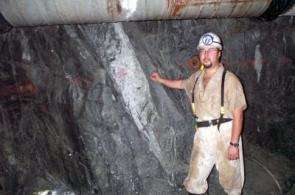Otherworldly bacteria that use radiated water for food discovered two miles down

Researchers have discovered an isolated, self-sustaining, bacterial community living under extreme conditions almost two miles deep beneath the surface in a South African gold mine. It is the first microbial community demonstrated to be exclusively dependent on geologically produced sulfur and hydrogen and one of the few ecosystems found on Earth that does not depend on energy from the Sun in any way. The discovery, appearing in the October 20 issue of Science, raises the possibility that similar bacteria could live beneath the surface of other worlds, such as Mars or Jupiter's moon Europa.
"These bacteria are truly unique, in the purest sense of the word," said lead author Li-Hung Lin, now at National Taiwan University, who performed many of the analyses as a doctoral student at Princeton and as a postdoctoral researcher at the Carnegie Institution's Geophysical Laboratory.
As Lin explained: "We know how isolated the bacteria have been because our analyses show that the water they live in is very old and hasn't been diluted by surface water. In addition, we found that the hydrocarbons in the local environment did not come from living organisms, as is usual, and that the source of the hydrogen (H2) needed for their respiration comes from the decomposition of water (H2O) by radioactive decay of uranium, thorium, and potassium."
Humans and most other land-dwelling organisms ultimately get their energy from the Sun, with photosynthetic plants forming the base of the food web. But in dark places where sunlight doesn't reach, life has to depend on other energy sources. Other communities of "chemoautotrophs"--a word chained together from Greek roots meaning "chemical self-nourishment"--have been found in exotic places such as aquifers, petroleum reservoirs, and vents linked to deep-sea volcanoes. Yet these communities all depend at least in part on nutrients that can be traced back to photosynthetic plants or bacteria.
The international team led by T. C. Onstott of Princeton University, which also includes Carnegie staff scientist Douglas Rumble and former Carnegie postdoctoral researcher Pei-Ling Wang, also now at National Taiwan University, found the community in a rock fracture that intersects the Mponeng gold mine near Johannesburg, South Africa. Water trapped in the fracture is home to the otherworldly bacteria.
Using genetic tools, the team discovered that there is very little species diversity in the rock fracture community. Compared with bacteria in the water used for mining, the fracture water is dominated by one type of bacteria related to Desulfotomaculum, which is known to get energy from the reduction of sulfur compounds.
"We also believe that the sulfate used by these creatures is left-over from ancient groundwater mixed with ancient hydrothermal fluid. We can detect that because the chemical signature arises from interacting with the fracture's wall rock," commented Rumble. "It is possible that communities like this can sustain themselves indefinitely, given enough input from geological processes. Time will tell how many more we might find in Earth's crust, but it is especially exciting to ponder whether they exist elsewhere in the solar system."
Source: Carnegie Institution


















